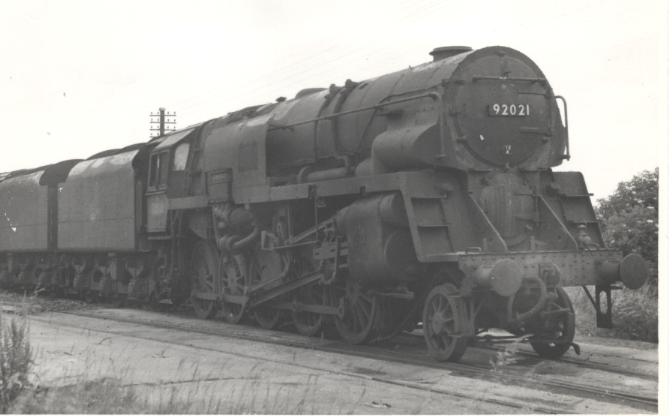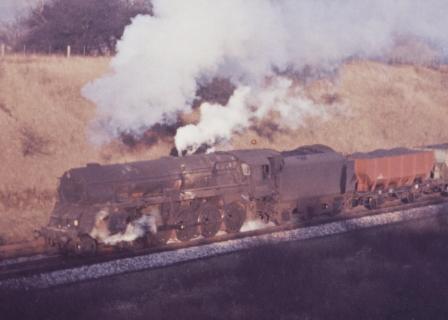BR Standard Class 9F 92020-9 on:
[Wikipedia]
[Google]
[Amazon]






British Railways
British Railways (BR), which from 1965 traded as British Rail, was a state-owned company that operated most of the overground rail transport in Great Britain from 1948 to 1997. It was formed from the nationalisation of the Big Four British rai ...
Standard Class 9F steam locomotives
A steam locomotive is a locomotive that provides the force to move itself and other vehicles by means of the expansion of steam. It is fuelled by burning combustible material (usually coal, oil or, rarely, wood) to heat water in the locomot ...
Nos 92020-9 were experimentally built with Franco-Crosti boiler
The Franco–Crosti boiler is a type of boiler used for steam locomotives. It was designed in the 1930s by Attilio Franco and Dr Piero Crosti.
The main difference between it and conventional feedwater heaters widely used on the continent is that t ...
s, thus forming a subclass. All ten were built in 1955 at Crewe Works
Crewe Works is a British railway engineering facility located in the town of Crewe, Cheshire. The works, which was originally opened by the Grand Junction Railway in 1840, employed around 7,000 to 8,000 workers at its peak. In the 1980s, a lot ...
.
The Franco-Crosti boiler took the form of a single cylindrical water drum running along the underside of the main boiler barrel; the standard chimney at the front was only used during lighting-up, in normal working the gases went through firetubes inside the preheater drum that led to a second smokebox situated beneath the boiler from which there emerged a chimney on the right-hand side (fireman's), just forward of the firebox.
Limitations of the British loading gauge
A loading gauge is a diagram or physical structure that defines the maximum height and width dimensions in railway vehicles and their loads. Their purpose is to ensure that rail vehicles can pass safely through tunnels and under bridges, and ke ...
meant that the original BR9 boiler had to be reduced in diameter to allow for the preheater drum below it. This new BR9A, later BR12, boiler had a reduced heating surface compared to the original, even with the additional preheater. Without the preheater, there was over 1,000 sq ft less heating surface.
In the event, the experiment did not deliver the hoped-for benefits, and efficiency was not increased sufficiently to justify the cost and complexity. Moreover, conditions were unpleasant on the footplate in a cross-wind, this in spite the later provision of a small deflector plate forward of the chimney. These problems led to the subsequent sealing off of the preheater drum, over the period 1959–1961, and the locomotives were then worked conventionally. As a result of this, there was a reduced ability to generate steam, and so their power classification
A number of different numbering and classification schemes were used for the locomotives owned by the London, Midland and Scottish Railway (LMS) and its constituent companies; this page explains the principal systems that were used.
The followi ...
was unofficially reduced from 9F to 8F.
All were fitted with the BR1B-type tender.
Stock list
Withdrawal
No. 92028 was the first Franco-Crosti 9F to be withdrawn in October 1966, 92027 followed in August 1967, with the remainder being withdrawn ''en masse'' in November 1967. No examples of this class were preserved.References
Further reading
* * Richard Derry ''The Book of the 9F 2-10-0s'' * Gavin Morrison ''The Power of the 9Fs'' OPC Railprint 2001 * H.C.B. Rogers, Riddles and the 9Fs (Ian Allan, 1982) * {{cite book , title=The British Steam Railway Locomotive , last=Nock , first=O.S. , volume=II, from 1925 to 1965 , publisher= Ian Allan , year=1966 , ref=Nock, Ahrons, British Steam Railway Locomotive , page=264–265 92020 Railway locomotives introduced in 1955 Scrapped locomotives